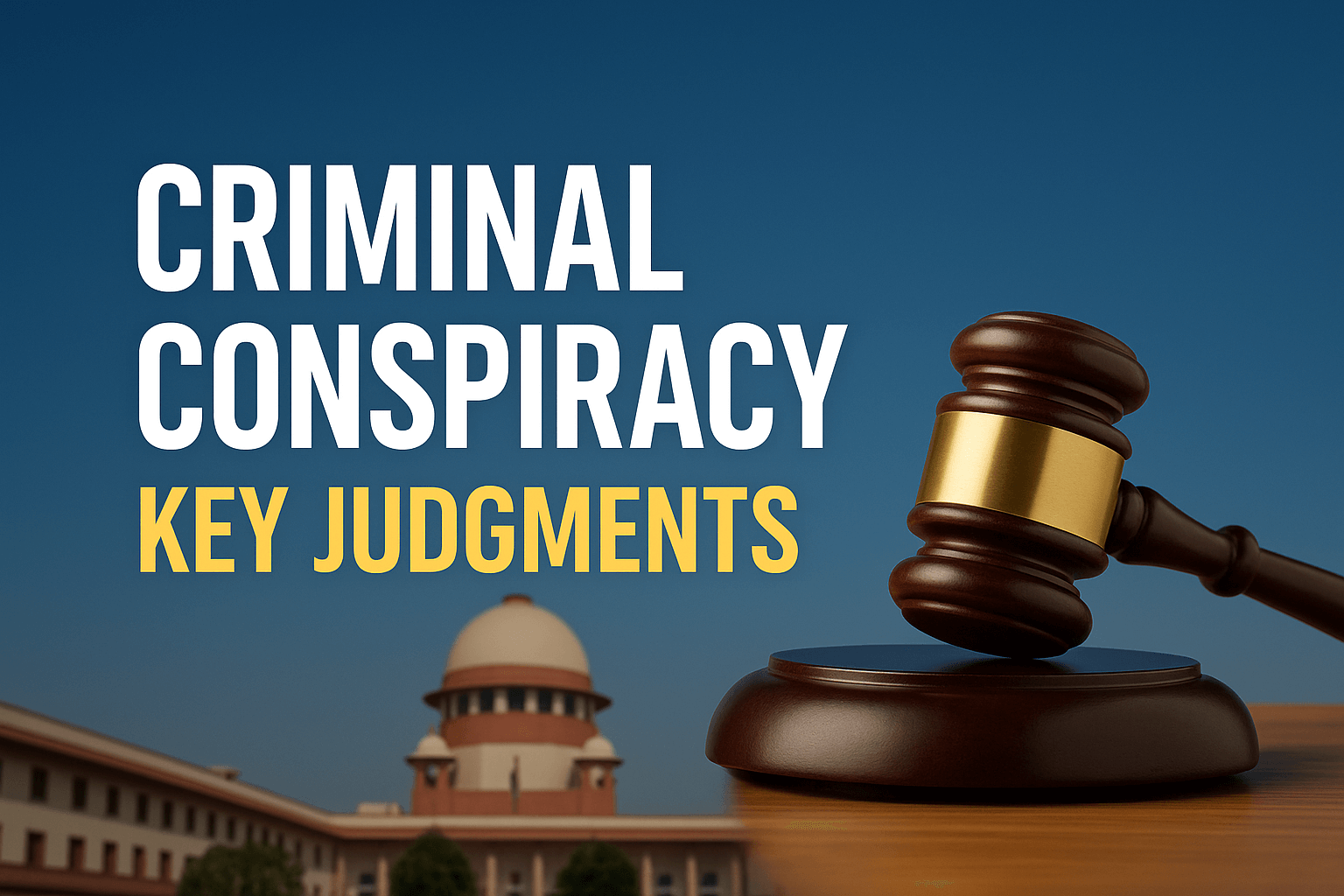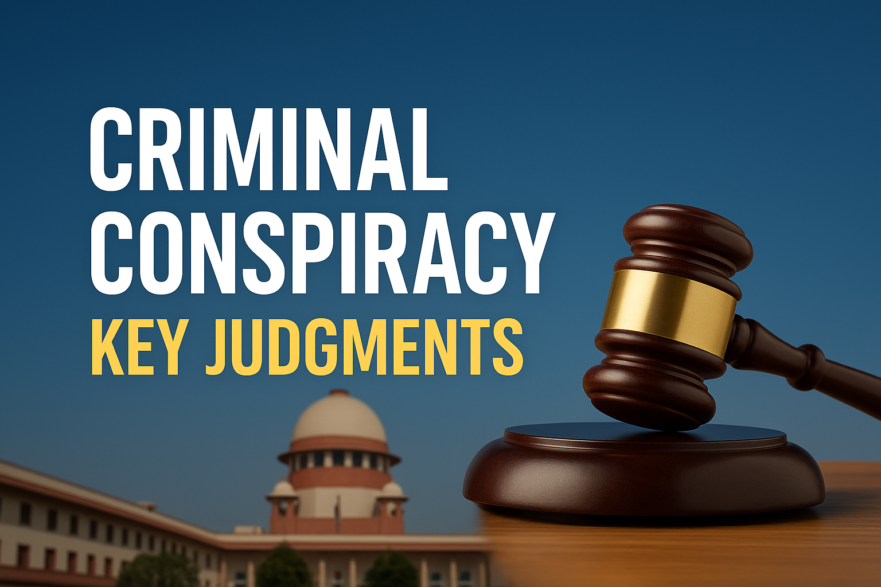
⚖️ Supreme Court Judgments on Criminal Conspiracy
Delhi Law Academy Jaipur presents below for aspirants of RJS, DJS, PCS(J) and other Judicial Services throughout India a compilation of important Supreme Court Judgments on an important topic in their syllabus, Criminal Conspiracy.
📑 Supreme Court Judgment 1
Major E.G. Barsay v. State of Bombay [AIR 1961 SC 1762]:
. … The gist of the offence is an agreement to break the law. The parties to such an agreement will be guilty of criminal conspiracy, though the illegal act agreed to be done has not been done. So too, it is not an ingredient of the offence that all the parties should agree to do a single illegal act. It may comprise the commission of a number of acts.’
📑 Supreme Court Judgment 2
In R.K. Dalmia v. Delhi Administration [(1963) 1 SCR 253] it was held that it is not necessary that each member of a conspiracy must know all the details of the conspiracy.
📑 Supreme Court Judgment 3
In Noor Mohammad Mohd v. State of Maharashtra [(1970) 1 SCC 696] it was held that Section 120-B IPC makes criminal conspiracy a substantive offence which offence postulates an agreement between two or more persons to do or cause to be done an act by illegal means. If the offence itself is to commit an offence, no further steps are needed to be proved to carry the agreement into effect.
📑 Supreme Court Judgment 4
In Shivanarayan Laxminarayan Joshi v. State of Maharashtra [(1980) 2 SCC 465] the Supreme Court emphasized that a conspiracy is always hatched in secrecy and it is impossible to adduce direct evidence of the same. The offence can be only proved largely from the inferences drawn from acts or illegal omissions committed by the conspirators in pursuance of a common design.”
📑 Supreme Court Judgment 5
In Mohammad Usman Maniyar v. State of Maharashtra [(1981) 2 SCC 443] it was held that for an offence under Section 120-B IPC, the prosecution need not necessarily prove that the conspirators expressly agreed to do or cause to be one the illegal act, the agreement may be proved by necessary implication.
📑 Supreme Court Judgment 6
In Ajay Aggarwal v. Union of India (1993) 3 SCC 609 it was reiterated that conspiracy is a continuing offence, which begins with the formation of the unlawful agreement and continues until the common objective is either achieved or abandoned. The court clarified that the crime is complete with the agreement itself and that no overt act is necessary to sustain a conviction under Section 120B IPC.
📑 Supreme Court Judgment 7
State (NCT of Delhi) v. Navjot Sandhu 6(2005) 11 SC 600
“Mostly, conspiracies are proved by circumstantial evidence, as the conspiracy is seldom an open affair. Usually, both the existence of the conspiracy and its objects have to be inferred from the circumstances and the conduct of the accused. The well-known rule governing circumstantial evidence is that each and every incriminating circumstance must be clearly established by reliable evidence and “the circumstances so proved must form a chain of events from which the only irresistible conclusion about the guilt of the accused can be safely drawn and no other hypothesis against the guilt is possible”
📑 Supreme Court Judgment 8
K.R. Purushothaman v. State of Kerala [(2005) 12 SCC 631]:
“To constitute a conspiracy, meeting of minds of two or more persons for doing an illegal act or an act by illegal means is the first and primary condition and it is not necessary that all the conspirators must know each and every detail of the conspiracy. Neither it is necessary that every one of the conspirators takes active part in the commission of each and every conspiratorial acts. The agreement amongst the conspirators can be inferred by necessary implication. In most of the cases, the conspiracies are proved by the circumstantial evidence, as the conspiracy is seldom an open affair. The existence of conspiracy and its objects are usually deduced from the circumstances of the case and the conduct of the accused involved in the conspiracy. While appreciating the evidence of the conspiracy, it is incumbent on the court to keep in mind the well-known rule governing circumstantial evidence viz. each and every incriminating circumstance must be clearly established by reliable evidence and the circumstances proved must form a chain of events from which the only irresistible conclusion about the guilt of the accused can be safely drawn, and no other hypothesis against the guilt is possible. The criminal conspiracy is an independent offence in the Penal Code. The unlawful agreement is sine qua non for constituting offence under the Penal Code and not an accomplishment. Conspiracy consists of the scheme or adjustment between two or more persons which may be express or implied or partly express and partly implied. Mere knowledge, even discussion, of the plan would not per se constitute conspiracy. The offence of conspiracy shall continue till the termination of agreement.”
📑 Supreme Court Judgment 9
Sudhir Shantilal Mehta v. CBI (2009) 8 SCC 1
“Criminal conspiracy is an independent offence. It is punishable independent of other offences; its ingredients being:
(i) an agreement between two or more persons.
(ii) the agreement must relate to doing or causing to be done either
(a) an illegal act;
(b) an act which is not illegal in itself but is done by illegal means.
It is now, however, well settled that a conspiracy ordinarily is hatched in secrecy. The court for the purpose of arriving at a finding as to whether the said offence has been committed or not may take into consideration the circumstantial evidence. While however doing so, it must bear in mind that meeting of the minds is essential; mere knowledge or discussion would not be.”

